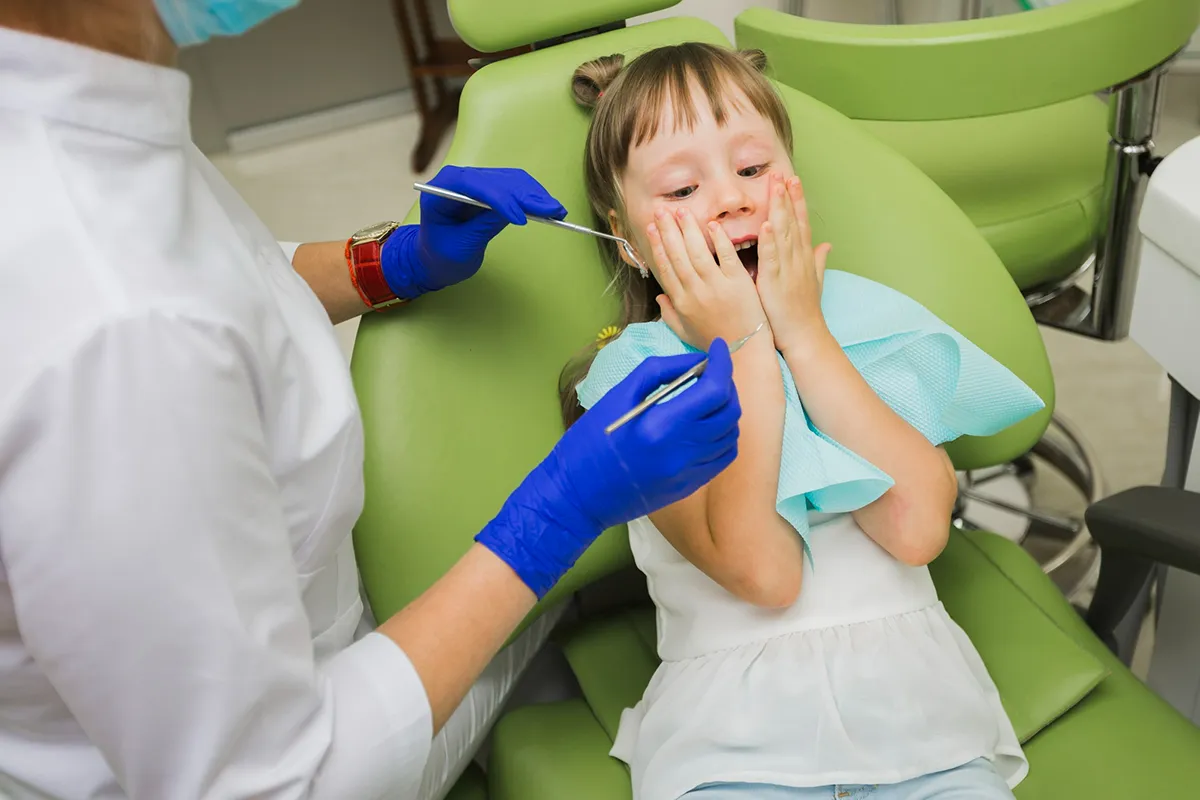Types of Pediatric Dental Pulp Therapy
Pulp therapy is a dental procedure used by pediatric dentists to save a severely decayed primary tooth. The decay in this tooth is so severe that it reaches the tooth’s pulp layer. Some parents might wonder, why preserve a damaged baby tooth when it eventually falls out? Losing a baby tooth too soon can interfere with your child’s speaking and chewing ability. It can also affect the alignment of permanent teeth or allow adjacent teeth to shift. When this happens, it results in an overcrowded mouth and some bite problems. On the other hand, if this baby tooth has been saved, it could create a strong foundation for the upcoming permanent teeth.
Pediatric pulp therapy aims to treat trauma in the tooth and prevent it from being lost. Pulp therapy helps restore the integrity and health of the affected tooth and allows the root to develop normally. Tooth decay is common among children worldwide, and it could interfere with your child’s primary tooth. Therefore, as a parent, you must know the signs of a damaged dental pulp and the available treatment options. Fortunately, the damaged dental pulp can be treated by pediatric dentists with two kinds of treatments. Let’s get to know these.
What is Pediatric Pulp Therapy, and When Is It Required?
The dental pulp plays a significant role in strengthening the vitality of the tooth. The tooth’s pulp produces dentin, which supports the tooth enamel. However, if it’s lost or damaged, it can restrict the blood and nerve supply to the tooth. When this happens, the tooth will fall out on its own, which could interfere with the rest of the teeth. Pediatric pulp therapy is a restorative technique to save the child’s tooth by treating damage to the tooth’s pulp.
According to the American Academy of Pediatric Dentistry (AAPD):
“The primary goal of pulp therapy is to maintain the integrity and health of the teeth and their supporting tissues while maintaining the vitality of the pulp of a tooth affected by caries, traumatic injury, or other causes.”
Your child’s dental pulp can become infected or exposed due to an injury, trauma, or severe dental decay. Pulp therapy aims to treat damaged dental pulp and helps preserve the tooth from being lost. Pediatric dentists perform pulp therapy on children, which can be applied to both baby and permanent teeth. Though baby teeth come out eventually on their own, dentists try to preserve them so they aren’t lost prematurely. Pediatric pulp therapy is a complete treatment option to treat damaged dental pulp.
Warning Signs of a Damaged Dental Pulp
The most common sign of a damaged dental pulp is pain. This pain can be accompanied by gum sensitivity, aches in the jaw, or headaches. Other potential symptoms include:
- High tooth sensitivity
- Swelling of the gums
- Sleeping difficulty
- A sensation of heat in the gums
- General pain in the mouth
- A specific tooth that hurts

If your child has dental pain or has sustained an injury to the mouth, immediately visit a pediatric dentist. Prompt treatment of damaged dental pulp can help restore the tooth’s function and overall health.
Types of Pulp Therapy: Pulpotomy and Pulpectomy
There are two types of pediatric pulp therapy: pulpotomy and pulpectomy. The former is performed when the tip of the pulp is damaged, but its root is OK. The latter is applied to damaged root canals and the crown. A pulpotomy is performed if the decay or damage is only up to the pulp’s tip. In contrast, a pulpectomy is performed when the damage exceeds the tip and extends to the roots.
The area surrounding the affected tooth is numbed in both these therapies. Moreover, the dentist ensures that the child patient sits comfortably and avoids any dental exam during the procedure. Dental sedation options can also be availed for these procedures whenever necessary. Types of dental sedation during these therapies might include:
- Nitrous oxide and oxygen analgesia (also known as laughing gas)
- Conscious sedation
- General anesthesia
- IV (Intravenous) sedation
You can discuss with your child’s dentist the sedation option that your child requires. Pulp therapy is considered safe for children; however, it should be performed by a pediatric dentist for the best results.
Explaining Pulpotomy Vs. Pulpectomy and Their Procedural Steps
Pulpotomy is a procedure that aims to remove the coronial portion of the tooth’s pulp. Studies show that if the damaged pulp can be removed from the pulp’s tip, the remaining pulp can remain intact. In other words, exposed areas of the pulp could be the only area that damages the pulp tissue. When it is removed, the pulp can perform its usual function. Now, the question arises; how to know if your child needs pulpotomy therapy? Here are a few factors that can qualify your child to go for pulpotomy therapy:
- Your child has only partial coronal pulp infection.
- There is no history of excessive tooth sensitivity or gum disease.
- The pulp can recover, and most of the child’s teeth are healthy.
Pulpotomy therapy can be performed on both baby and permanent teeth. However, it is only applied when the tooth’s root has not been affected. The dentist will eliminate the infected pulp from the tooth’s crown. Afterward, the area is filled with a biocompatible material to restrict further infections. Moreover, it helps calm the tooth and prevents tooth inflammation.
Furthermore, the dentist can also place a crown on the top of the tooth. It helps to prevent future decay and restores normal tooth function. The pulpotomy procedure usually requires local anesthesia, wherein nitrous oxide might also be administered. It helps to calm the child during the process.

A pulpectomy is known as a baby root canal or pulp canal treatment. It is only performed on non-vital teeth such as molars and primary teeth. This procedure removes the radicular and coronal pulp or the entire tissue pulp. Pulpectomy helps to treat a tooth that has undergone severe decay, pulp infection, or trauma. A generic qualifying criterion for pulpectomy includes considering the following factors:
- There is no other way by which the dental pulp can recover.
- The child’s tooth enamel is severely damaged.
- Infections are too close to the roots and the pulp chamber.
A pulpectomy is necessary when the entire pulp has to be removed from the tooth. During this procedure, the canals are cleansed and disinfected. Afterward, they are packed with materials such as Mineral Trioxide Aggregate, Ferric Sulphate, Bio Dentine (BD), or Calcium Hydroxide (CH). Finally, a crown supports the tooth and provides adequate protection and strength.
A pulpectomy is of two types: partial pulpectomy and complete pulpectomy. The former is similar to pulpotomy and removes the infected pulp only. The latter is a procedure that eliminates the entire pulp from a severely damaged or decayed tooth.
Which Pulp Therapy Suits Your Child?
The proper procedure for pulp therapy depends on the severity of the pulp damage. If it only affects the tip of the pulp, then a pulpotomy is usually the best choice. In contrast, if the entire pulp must be removed, the dentist recommends a pulpectomy. The dentist will administer a series of dental x-rays to evaluate which therapy suits your child. However, preparing your child in advance is essential to relieve his dental anxiety. Make him aware of the procedure, let him ask questions, and give some reinforcement to encourage your child for the treatment.
Final Thoughts
As it’s said, “prevention is better than cure” there are ways to prevent dental pulp damage in children. Some of these include maintaining good oral hygiene practices, having regular dental visits, and protection through custom mouthguards. The custom mouthguard will protect your child’s teeth from dental emergencies or trauma. However, if it still happens, now there are successful treatment options. One of these is pulp therapy which can be performed for a child’s baby and permanent teeth. Whether your child needs pulpotomy or pulpectomy depends on the tooth’s condition. However, finding a qualified specialist to perform such delicate procedures is essential.
Contact your Stockton pediatric dentist, Dr. Sajjad Rizvi, at Happy Kids Dental to learn about the types of Pediatric Dental Pulp Therapy.
Resource:
What is Pediatric Pulp Therapy?
This media/content or any other on this website does not prescribe, recommend, or prevent any treatment or procedure. Therefore, we highly recommend that you get the advice of a qualified dentist or other medical practitioners regarding your specific dental condition.
Subscribe To Our Newsletter
Get Updates And Learn From The Best


